spend R1000 & 2kg or less = free shipping.
Menu

spend R1000 & 2kg or less = free shipping.

Your Cart is Empty
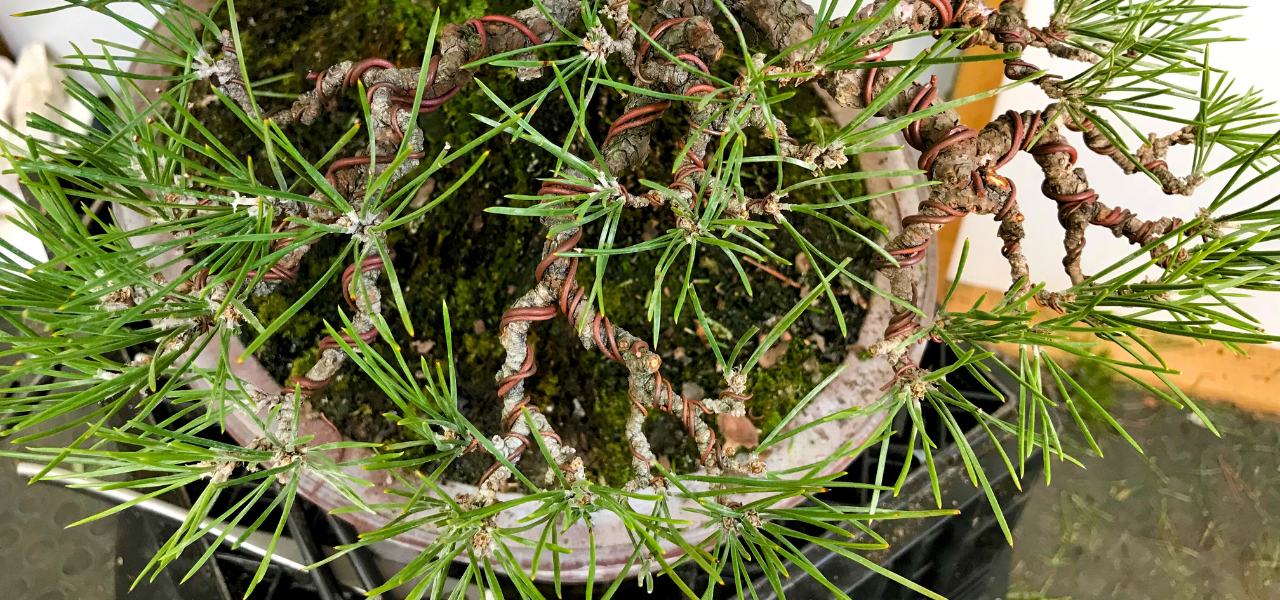
9 min read
Being able to wire effectively and quickly is a valuable skill for any bonsai grower. Wiring enables us to alter the shape of roots, trunk or branch. Rather than wait many years for a tree to grow into a particular shape using clip and grow technique, wire can be used to instantly alter the appearance of a bonsai tree.
Below are 15 tips shared by readers which are sure to help you wire your trees better.
"Wire tree starting from the lowest branch and work your way up. Also, when wiring, the branch will twist little by little in the direction of the wiring, one should use the twist of orientation to one’s styling advantage, and if twisting counter to desired, one can counter with offhand just in front wire placement action (basically lose counter rote branch and come forth with wiring hand until wire grabs it into that position). Both hands should be on the branch/wire. Making all bends only bend directions following the rotation of the wire."
Very sound advice there. If you can bear these great tips in mind when you are wiring your next tree you will find the wire much more functional and the whole experience more rewarding.
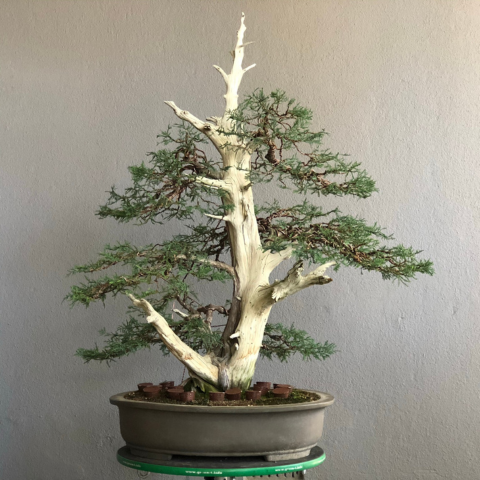
It would not have been possible to achieve this design without the aid of wire.
"If you want to bend a branch down you wrap wire over the branch and if you want to bend the branch up you wire underneath the branch . With memory loss my tip to easily remember the rule is think of opposites . up is under and down is over. Don't be afraid to wire. Practise makes perfect."
This is a great tip to remember as failure to use this strategy will see you see-sawing the branches when bent as the wire will not hold them in the bent position.
For sure, much like any art, the more you practise it the better you become.
"Gnarly branches, as Dan Robinson says, are great. Big bends create lots of movement which creates beautiful trees. Linear branches give a juvenile impression. Exaggerate the bends!"
This is most certainly true and especially valuable advice if you are creating shohin trees as they need to do so much more if they are to compete with the viewers attention when placed amongst larger trees. One also needs to seize the opportunity to put these bends into branches or trunks while the material being bent is still young enough to do so. The exaggeration comment is very valid too as plant material thickens as it ages and thus the bends become increasingly subdued so although they may look a little too wacky in the beginning, after time they mellow and are much more presentable.
"When bending a more lignified growth, the distance between wraps must be reduced. This will prevent the branch from splitting and keep the bark intact. When one gets a bit of experience, cracked branches and bark can be repaired but this method may require a finer wire. When directing growth in this method, I try to remember the roots mirror or balance the canopy. "As above so is below""
A good technique to remember when trying to wire lignified branches or branches of species such as camellia which snap easily, is to twist while bending. This spreads the stresses over a larger portion of material instead of focused on a single point.
Although it is possible to seal a crack in a branch and for it to heal over, it will always be a weak point on that branch and thus already prone to breaks in the future. So decide if it might not be easier to simply restart the branch further back.
"Though it can take decades to grow decent bonsai from seedlings, I personally find great joy in it because I can create dramatic movement in the trees from early on using thin wire. When doing this, be sure to make bends extra dramatic because the bends will smooth out as the trees grow and thicken out. Also, if you're afraid to bend seedlings, I suggest using wire loops or "guy-wires" to bend the young trees."
Growing material from seedlings can certainly open opportunities for creating dramatic motion which is not possible on older material. Guy wires can be useful although on seedlings it should not be necessary. Only use guy wires when absolutely necessary as they can only change the position of a branch or trunk in a single dimension and must also remain on the plant for some time so can often get in the way.
"When wiring- 1. Try not have more than 3 pieces of wire per branch. 2 make sure you wire in equal angles. 3. Wire in Equal distances."
Its true that you want to use as little wire as possible. Proper planning will definitely help you to achieve that goal. Equal angles are another ideal to strive towards but not always possible as a bud, leaf or branch might prevent this, so make adjustments on the fly as needed. Another good one would be to ensure there are no gaps between the wire and the branch as gaps = breaks.
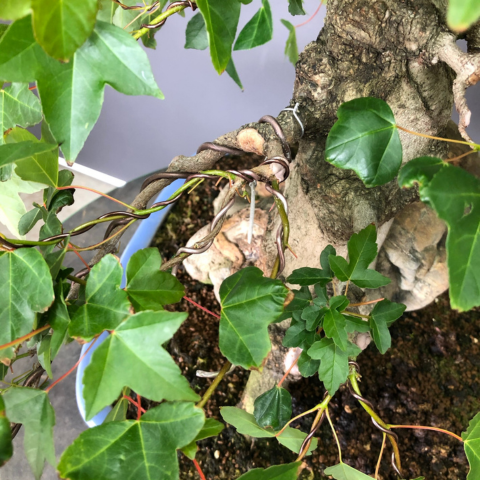
The degree of the bend determines the degree of the wire angles. Gentle bends require gentle angles.
"Make sure when bending thick and heavy branches to always use raffia if your scared of braking the branch and bend one bit at a time and listen for and sounds coming from the branches, when you hear something stop immediately - let the tree speak to you."
Raffia can be very useful when bending thick material but only of certain species. It makes no sense to put raffia on a maple for instance as the break, were one to occur, would be clean and raffia would serve no purpose. However on a juniper, raffia can reduce the risk of the wood splitting, this is what raffia is best at. Another good use for raffia is on thinly barked species such as azalea, olive, camellia and others to protect the bark from damage when wiring.
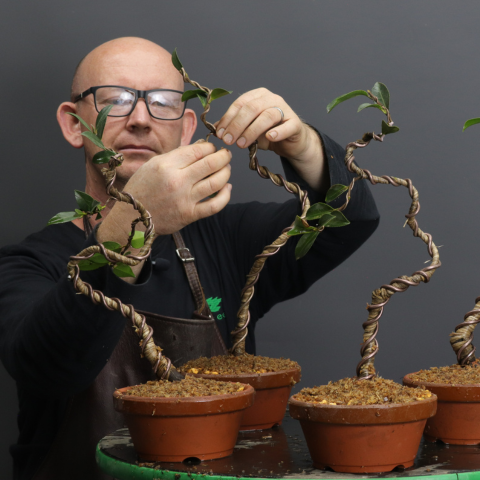
Raffia can be used not only to protect the trunk from splitting but also to prevent bark from being damaged by wire application.
"I believe the most important wiring tip is to wire (wrap) your branch with the correct rotational direction. If you need your branch/trunk to move and bend in a clockwise direction (left and right is relative): wrap the wire in a clockwise direction around the branch/trunk. This will make the wire tighten as the movement and bend is put into the branch/trunk, making the hold of the wire greater and stronger as it bends more and more. If the wire is applied in the wrong direction, it will simply loosen and unwrap itself as the movement is put into the branch/trunk. And at that point the wire becomes completely functionless. This is why I view this as the top wiring tip. Other important tips are to pinch and hold each new turn of the wire between finger and thumb in order to take the force and weight of wrapping the wire off the branch. Also, bend your branches by using your thumb to create a fulcrum to support the branch as it bends."
Nothing to add here, follow this advice and you will find wiring to be effective and more enjoyable.
"In today's day and age of consumerism, reusing material and making the art of bonsai more sustainable. An easy way to reuse your aluminum wire is to grab the two ends and pull it against a branch or tree. This removes the bends and returns it to a straight piece of wire ready to be used on your next project."
Yes, you can re-use aluminum wire several times if you wish to go through the effort of straightening the pieces. However I often find that it is safer to cut wire off of a branch than trying to unwind it and risk snapping the branch. I would certainly never unwind wire because I intend to reuse it. However there are occasions when unwinding is safe. If you value your time however for most people it is cheaper simply to purchase more wire.
I would highly encourage you however to have 2 containers in which you can save used wire, sorting aluminum together and copper separately. When these containers are full you can take them for recycling - you may even get a little money back.
"My best tips for beginners is to take a branch of a big tree and practice your 45° angles and get a feel for wiring. Use the correct thickness for ultimate results. When removing wire rather cut it than try to unwrap it. Use both hands to guide the wire and be careful of trapping any foliage as this will die. Have fun and remember to check it regularly to avoid the wire biting into the tree."
Wiring is often not done at 45 deg as the books depict. It depends on the kind of bends you need to put into the branch. If you are going for subtle bends then you can use a far gentler angle, this also reduces the amount of wire which is needed.
Wire bite can be a big problem on species such as Japanese maple, azalea, olive and other thinly barked species as it takes forever to vanish. However a little wire bit is good as it means the branches should largely retain their position once the wire is removed. Removing wire prematurely will result in the branches returning to their original position and essentially mean all the time spent was wasted.

I always prefer to cut wire off rather than to unwind it.
"You can artificially thicken the trunk of young trees (mostly conifers) by allowing harsh wire bite, you must just be careful to not let it get to the point where you would damage tree when removing the wire. Bonus tip, you can reuse wire, never waste!"
Wiring young Japanese black pine and keeping the wire on until it bites in severely is a great technique for fattening the trunk rapidly. You can find out more about that here.
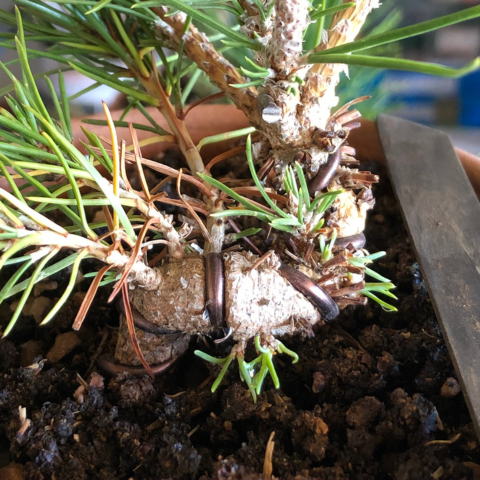
Wire bite can be useful sometimes, but is generally to be avoided.
"Generally, use wire that is a 1/3 of the branch thickness. Rather go thicker and use a single wire than using a wire that is too thin and using more."
Wire gauge selection is definitely made easier with experience as it is not simply the thickness of the branch but also the species of plant and the age of the branch. However correctly selecting the wire is crucial to keeping wire to a minimum. Using wire which is too think though is likely to cause breaks in the branches though during application.
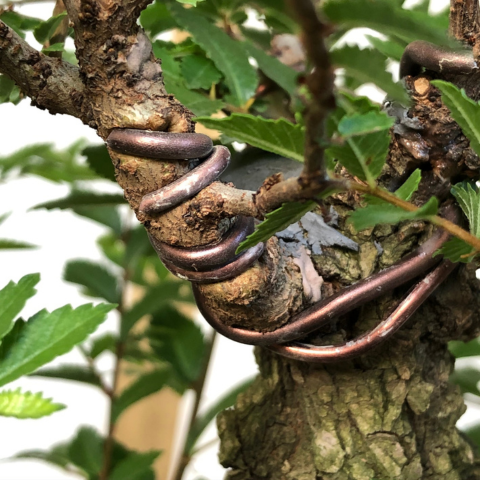
Wire bite on deciduous trees should be kept to a bare minimum but on corked varieties, the evidence of wire bite is less obvious.
"Always use the 2 branch principle to anchor each other firmly."
This is indeed a great technique and one which I often follow however it is not a rule and I don't always follow it as the circumstances do not always demand it. However wire should always be properly anchored. This may mean you need to wire twice around the trunk before wiring the branch you want to shape.
"Always seek to use the opportunity to train new recruits when wiring a thorny acacia."
I love this! Wiring thorny acacia is not my favourite pastime either. Cutting the thorns though does make it less bloody.
"It's important to make sure that your tree is healthy before wiring. Delicate, unhealthy or recovering branches can otherwise suffer when being shaped. I mainly work with deciduous trees and have found that late winter is the optimal time to wire these as the spring growth is around the corner and the dormant tree is coming back to life. It's important to monitor the tree's growth as the branches can quickly scar if wire is left on for too long. I try to wire as many branches of the tree at the same time. I have found that if this is not done, unwired branches may grow more vigorously, and wired branches can have a somewhat stunted growth, unfortunately leading to an unbalanced tree with varying levels of foliage health and density. I usually work with anodized aluminium wire. Although annealed copper work hardens and results in a better hold (usually used for conifers), working with this type of wire can damage the tree as it is stiffer. If branches are brittle and undergoing severe bends, wrap the branch in raffia (a palm fiber) and use two wires on the same branch, with a slight gap in between their wraps to prevent snapping."
Great advice, nothing to add to this tip.
Comments will be approved before showing up.

Exclusive Offer: Buy 2 Venus Fly Traps, Get the 3rd One FREE - Limited Time Only!
Add three, six, nine or any other multiple of three of our hungry fly traps to your cart and the discount is automatically applied.